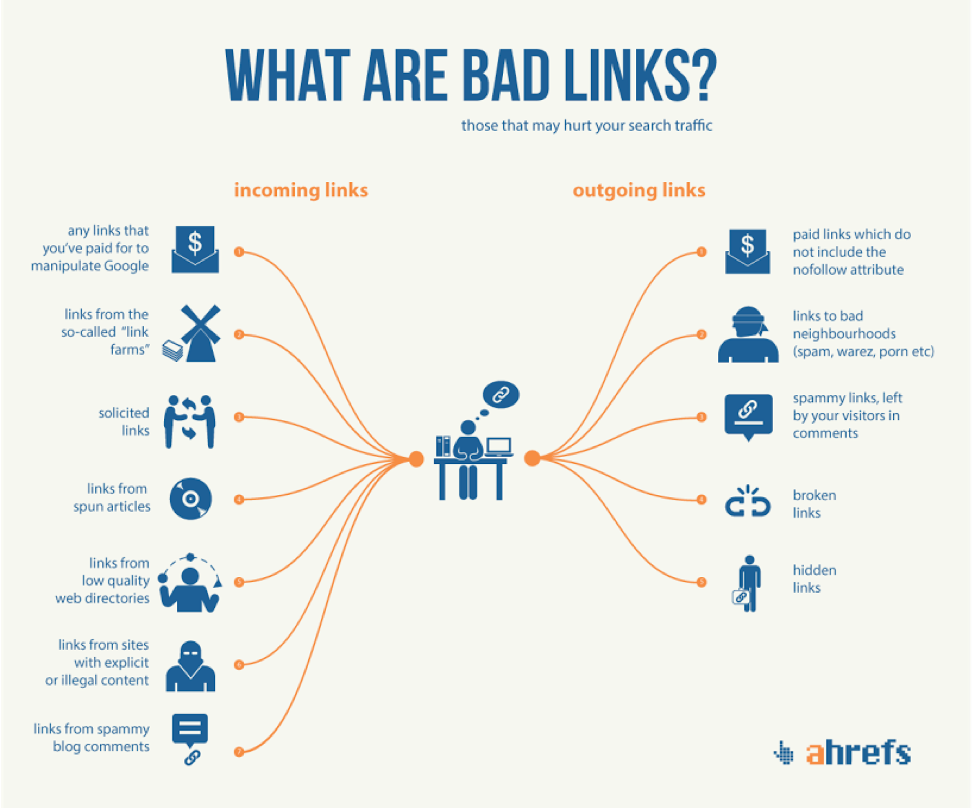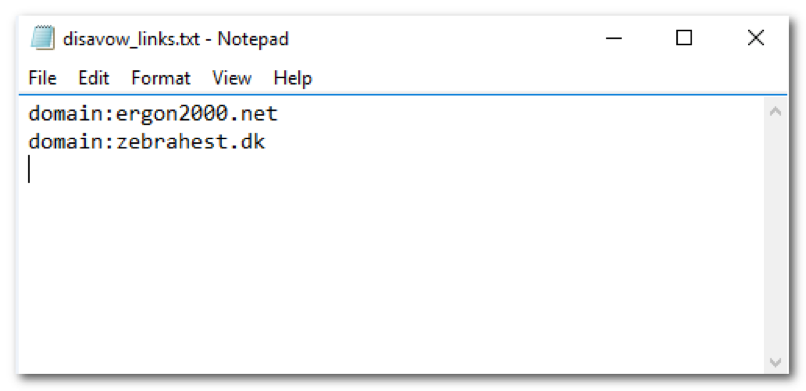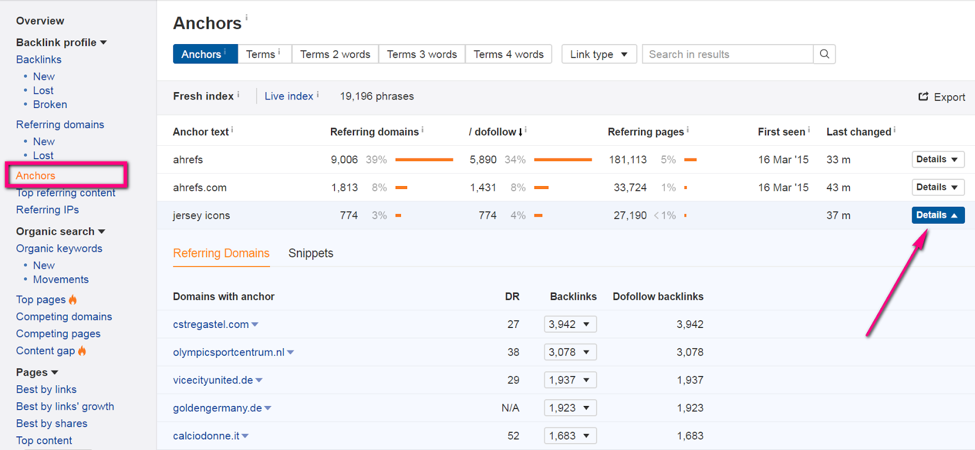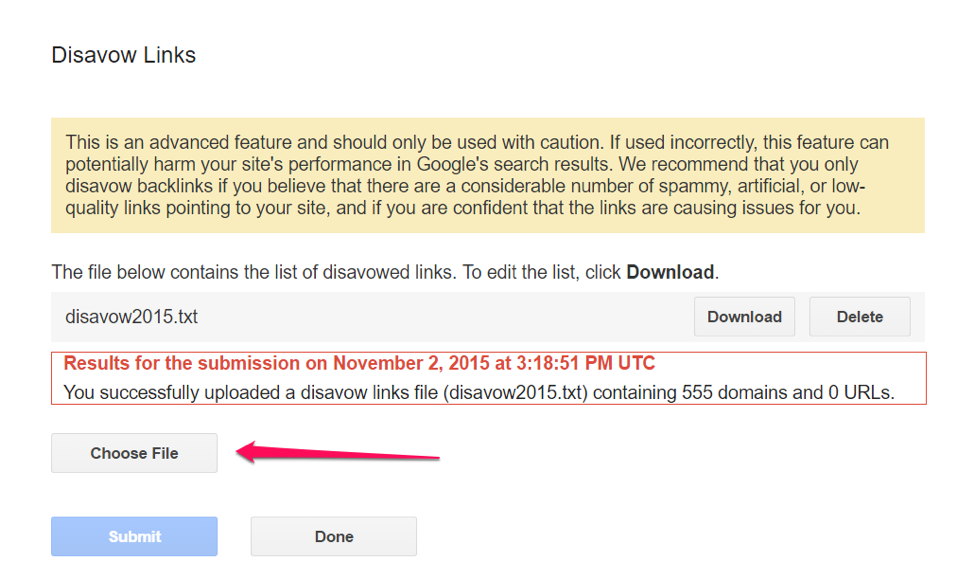Let’s play word association! What’s the first thing that comes to your mind when you hear the word “penguin”?
If you’re thinking about a cute, flightless bird, then there’s nothing wrong with you, congratulations. But if you immediately thought of link schemes, spam backlinks, and Google penalties, then your tastes are very... singular. Which means that you’re working in SEO! Feel free to be a little proud.
However, I’ve found out that even if people can distinguish a penguin from Penguin, they often can’t stop spam backlinks from damaging their website. That’s because we’re inclined to think that each new backlink is a good one.
Sadly, that’s not the case. This is why I want to talk about bad backlinks, how they can hurt your rankings, and what can you do to stop them from doing so.
1. Why would I care about spam backlinks, anyway?
I know what you’re thinking. Each time we get a new backlink, we’re making a tiny step towards a better search position. The more, the merrier. Backlinks should be great, right?
Wrong. Well, at least not exactly right.
Here’s the thing. Some backlinks are so nasty that they can throw a shadow on your whole backlink profile which you’ve been building for so long. That shadow may eventually lead to a Google penalty.
[bctt tweet="Some backlinks are so nasty that they can throw a shadow on your whole backlink profile. That shadow may eventually lead to a Google penalty." username=""]
Not all backlinks are created equal. At the back of SEO, there’s a thing called spam backlink, which is basically a link to your page placed on a trashy, irrelevant website with some random, ill-fitted anchor text.
Not good for your image, right? That’s what Google thinks of it, too.
Such bad backlinks usually come from cheap Fiverr gigs, Scrapebox comment spam or a link network.
In many cases, if you discover that a lot of Chinese (.cn) or Russian (.ru) domains are suddenly linking to your website, it can (and probably will) be a good indicator of low-quality backlinks.
Quantity is important here. There’s sure to be a couple of spam backlinks for your website already. But if there are too many of them, it’ll look like you’re trying to use shady SEO tactics to manipulate your rankings.
As a result, Google can take action against you. That’s exactly what they created the Google Penguin algorithm for. If fights against bad links and, while generally making the internet a better place, it could destroy your website along the way.
Sidenote! (aka a few sentences of boring historical data).
You’re probably wondering where all this good/bad backlinks buzz is coming from.
You see, from the very first day of SEO, backlinks were a strong ranking signal for search engines. Website owners were trying to gain as many of them as possible to win this SEO rally.
That’s when all the shady link building tactics appeared.
Bloggers were going nuts placing links to their websites in all sorts of places—on forums, anywhere in the comment sections, on link farm sites (which exist solely for the purpose of placing all kinds of links on them), or in link directories.
At some point, Google said ‘enough’ to this manipulation.
In 2012, they rolled out their Penguin algorithm. Its primary goal was to fight against backlink spammers and penalize their websites.
2. Where do these spam backlinks even come from?
Google took action. They started banning “link schemes” and stated once again that “any links intended to manipulate PageRank or a site’s ranking in Google search results may be considered part of a link scheme and a violation of Google’s Webmaster Guidelines.”
This basically means that if you’re spamming links, Google could remove you from their search query. Imagine how bad that would be.
You may ask why it should matter to you if you’re not dealing with shady SEO tactics and you have certainly never bought a single backlink in your life? Well, that’s because of negative SEO, as spam backlinks are among the most wide-known negative SEO tactics.
[bctt tweet="Spam backlinks are among the most wide-known negative SEO tactics." username=""]
In case you didn’t know, negative SEO is what your competitors can do to harm your rankings. And as disheartening as it sounds, you won’t find out who is attacking you. All you can do is defend yourself.
Source: Reddit
The term is opposite to “positive SEO”—a set of measures you take to optimize your website properly and get it ranked high.
For instance, your competitors can hack your website (worst case scenario) or send fake reports about your website to Google. Or, they can build a ton of low-quality links to your site and eventually get it penalized.
In any case, if you fall victim to a negative SEO attack, it’s really important to spot it early on and take measures against it. Thankfully, getting rid of bad backlinks is easy—if you know the trick.
3. What do I do if my website does have spam backlinks?
First of all, take a deep breath and relax. After what you’ve just read, you probably want to check upon your backlinks right away and report all of them to Google, just to be on the safe side.
Relax, though. As far as you’re not involved in some unashamed link manipulation, Google will not punish you for a few spam backlinks.
All you need to do is to check your backlink profile from time to time and clean it from those sneaky spam bastards.
The whole process of fighting against spam backlinks comes down to the following three simple steps:
- Detect all of the spam backlinks your website has;
- Compile a list of all toxic domains (in .txt format);
- Disavow them from Google with the help of Google Disavow Tool (or simply report those backlinks to Google, and it will ignore them).
Now let’s drill down these three steps in details.
4. How do I detect spam backlinks that my website has?
As always, there’s a tricky part. The best way to find toxic backlinks is to review them manually. But how do you approach finding spammy backlinks and auditing your website on your own?
Well, the easiest way—and the one I’m recommending—is going for specialized SEO tools.
If you’re thinking about such toolsets as very specific instruments only professionals would need, think again. Such tools as Ahrefs, SEMrush, Moz, or Majestic are handy for a regular checkup on your website’s health. And there’s no better way to fight spam backlinks.
I’ll explain the process on Ahrefs, but it’s more or less similar between all the SEO toolsets.
Sidenote!
These days, a lot of such SEO tools are trying to find an automated solution that will accurately identify bad links right away.
For instance, SEMrush came up with its Backlink Audit Tool that informs you if your domain is at risk of being penalized.
However, there’s no tool that can be as precise as manual review. At least at this point.
It must be noted that finding bad backlinks is around 90% of all the work. When done, you will only need to upload the list of toxic domains to Google and celebrate the win.
There are two best working methods for finding spam backlinks:
- Method #1. Detecting low-quality websites that link to you.
- Method #2. Identifying spammy anchor texts.
Important!
Before we proceed with describing each of these methods, create a .txt file so that you can throw each suspicious link that you find into it. When all is said and done, you’ll send this file to Google.
Now, ready to cut those bad links to ribbons? Let’s do it!
Method #1. Detect low-quality websites that link to you.
In the simplest terms, a low-quality backlink will usually originate from a low-quality website. Sounds natural, doesn’t it?
So the only thing we should do is find those trashy websites. Different tools use their own metrics to measure how strong and reliable a particular domain is.
Moz uses Domain Authority, SEMrush has its Domain Score, and so on. In Ahrefs, it’s called Domain Rating (or just DR).
Here’s how to find that “fly in the ointment”:
- Put your domain into the Ahrefs Site Explorer Then, locate the option called “Backlink profile” in the left menu. What you’ll need for further audit is its “Referring domains” report which will show you the list of all the websites that are linking to you.
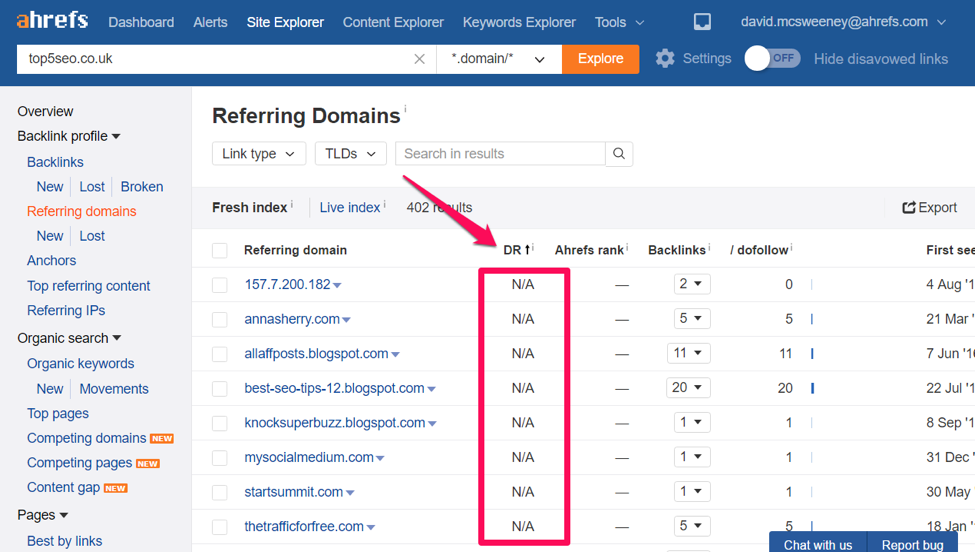
- The next step would be to sort out the list of referring websites by their quality—from the lowest Domain Rating (DR) to the highest. To do this, just click on the corresponding column.
- Now, don’t rush into deleting all backlinks from low-DR websites. You have to investigate each suspicious domain further. Look for common spam indicators such as spammy sounding domains, lots of foreign (specifically Chinese (.cn) or Russian (.ru)) domains, sites that obviously don’t belong to your niche, etc.
- After detecting such a suspicious domain, click on the number under the “Backlinks” column for more details on each backlink that comes from it.It is the last step of making sure that a given backlink is reallyLook at its anchor text. If it sounds suspicious, incoherent, or it doesn’t coincide with your niche, it is a strong and the most reliable signal of a spam backlink.

- You can also click on the suspicious link to check if the content on that page is of low quality and then be ready to disavow your dangerous finding from Google.
Method #2. Identify spammy anchor texts.
Another way to find spam backlinks is to look at the anchor texts straightaway.
You see, if you spot a lot of same irrelevant anchors that don’t really reflect the content of your page, it’s a wake-up call. Most certainly, those links are spam and can lead to Google penalizing your site.
In other words, it’s no good if your video game blog is linked to from a dozen websites under the anchor text “adult videos”.
Again, good old SEO tools will come in handy for this task. Most of them offer this feature as a separate report within their tools, so you can check out anchor texts quickly and with no hassle.
In Ahrefs Site Explorer, the needed report is called “Anchors” and is located in the left menu.
To find bad backlinks, hit the Details button near the identified suspicious anchor text and you’ll get a list of spam referring domains.
5. How do I disavow bad backlinks from Google?
At this point, we’re in a pretty good place. You have the list of dangerous backlinks/domains in your hand, so most of the dirty work is done.
What’s left is to tell Google you don’t want those toxic backlinks and disavow them from Google Search Console (that’s where that .txt file you’ve been creating takes the stage).
Sidenote!
With the help of SEO tools, you can automatically create a disavow file in .txt format. All you need to do is mark suspicious domains and export the list from the dashboard. There’s usually a separate button for that.
To get this party started, you will need to log in to the Google account associated with your domain and go to the Disavow Tool.
Its interface is as simple as it gets: just upload your disavow file and click on the button. Also, remember that you can disavow each backlink separately or the entire linking domain as you prefer.
You don’t have to worry now as Google will pick up the changes really fast and those links won’t hurt your SEO any longer.
Bottom line
Spammy backlinks are usually more annoying that hurtful, but there’s a real possibility they could destroy your website’s reputation in Google. That’s why it’s important never to give them a chance to do that.
Make checking your backlink profile a healthy habit. It’s also an excellent idea to plunge into it if you see a sudden traffic jump or drop that you can’t explain.
Invest in a good SEO toolset of your choice if you’re serious about keeping your website safe and healthy. Such regular checkup can not only save you from spam overload but also give you a few great content ideas or outreach opportunities.
Speaking of which… If you see a small website with a weird domain name that is linking to your content, don’t just run off to disavow it. Don’t fear giving it the benefit of the doubt. Maybe it’s some independent blog that will become popular in a few years, who knows?
And if you find a backlink you don’t want from a website that’s actually not spam, don’t rush reporting it to Google. It’s still recommended to contact the website owners and ask them politely to remove the links you don’t want there. After all, we’re humans, not penguins.


